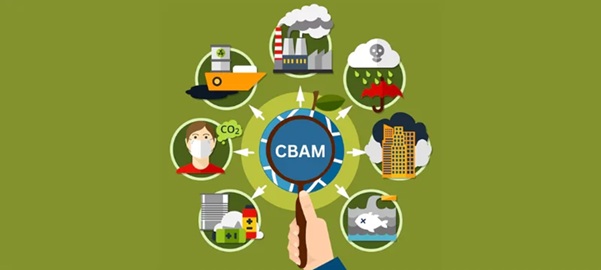Why in News ?
- The European Union (EU) has started implementing the Carbon Border Adjustment Mechanism (CBAM) as part of its “Green Deal” to tackle climate change.
- This policy impacts countries that export high carbon-emitting products to Europe — including India.

What is CBAM ?
- CBAM is a carbon tax-like mechanism imposed on imported goods in the EU to offset the carbon emissions generated during their production.
- In simple terms: If a product is manufactured in a country with high carbon emissions, it will attract an additional charge (carbon tax) when it enters the European market.
Objectives of CBAM
- Prevent Carbon Leakage – To stop companies from relocating production to countries with weaker environmental regulations.
- Ensure Fair Competition – To create a level playing field for EU industries that already comply with strict Emission Trading System (ETS) rules.
- Encourage Global Green Transition – To motivate other countries to reduce emissions in their manufacturing processes.
Sectors Covered under CBAM
Initially (2023–2025), the following sectors are included:
- Iron & Steel
- Cement
- Aluminium
- Fertilizers
- Electricity
- Hydrogen
(Other products such as chemicals and plastics may be added later.)
Implementation Phases
|
Phase
|
Duration
|
Key Features
|
|
Transitional Phase
|
Oct 2023 – Dec 2025
|
Only reporting required – exporters must disclose carbon emissions of their products.
|
|
Full Implementation
|
From Jan 1, 2026
|
Actual carbon levy will be imposed; exporters must buy CBAM certificates.
|
Impact on India
- Effect on Exports
- India is a major exporter of steel, aluminium, and cement to the EU.
- CBAM will make these products costlier, reducing competitiveness.
- Industrial Pressure
- Indian industries will face pressure to reduce emissions and adopt cleaner technologies.
- Investment Opportunities
- It may create new opportunities in green energy, carbon capture, and renewable technologies.
India’s Concerns
- Unequal Burden on Developing Countries
- CBAM goes against the principle of Climate Justice, as developing nations are still in their industrialization phase.
- Violation of WTO Norms
- It acts like a trade barrier and contradicts the principles of free trade under the WTO.
- Administrative Complexity
- Measuring, reporting, and verifying carbon emissions involves complex processes.
India’s Response and Preparedness
- Carbon Credit Trading Scheme (CCTS), 2023: Encourages domestic industries to improve carbon efficiency.
- National Green Hydrogen Mission and Energy Transition Plan: Aim to decarbonize Indian industries.
- Global Advocacy: India continues to emphasize equity and climate justice at international platforms.
Global Outlook
- The U.S. is also considering a Carbon Border Tax.
- Canada, Japan, and the U.K. are planning similar mechanisms.
- The “Cost of Carbon” is becoming a major economic factor in global trade.
Criticism and Challenges
- Seen as a form of protectionism by the EU.
- Reduces competitiveness of non-EU exporters.
- Developing nations face financial and technological barriers in adopting green technologies.
- Complex monitoring and reporting mechanisms.



